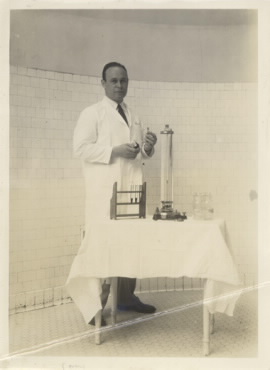Charles Richard Drew
“Father of the Blood Bank”
June 3, 1904 – April 1, 1950
Renowned surgeon and pioneer in the preservation of life-saving blood plasma
Major scientific achievements:
- Discovered method for long-term storage of blood plasma
- Organized America's first large-scale blood bank
Dr. Charles Richard Drew broke barriers in a racially divided America to become one of the most important scientists of the 20th century. His pioneering research and systematic developments in the use and preservation of blood plasma during World War II not only saved thousands of lives, but innovated the nation’s blood banking process and standardized procedures for long-term blood preservation and storage techniques adapted by the American Red Cross.
A native Washingtonian, Drew was an average student but gifted athlete recruited in 1922 on a football and track and field scholarship by Amherst College in Massachusetts. He was one of only 13 African Americans in a student body of 600, where the racial climate exposed him to hostility from opposing teams. His own football team passed him over as captain his senior year even though he was the team’s best athlete.
Beyond sports, Drew didn’t have a clear direction until a biology professor piqued his interest in medicine. Like many other fields, medicine was largely segregated, greatly limiting education and career options for African Americans. For Drew, the narrowed road would lead him to McGill University College of Medicine in MontrÉal. There, he distinguished himself, winning the annual scholarship prize in neuroanatomy; becoming elected to the medical honor society Alpha Omega Alpha; and staffing the McGill Medical Journal. He also won the J. Francis Williams Prize in medicine after beating the top 5 students in an exam competition. In 1933, Drew received his MD and CM (Master of Surgery) degrees, graduating second in a class of 137.
Drew’s interest in transfusion medicine began during his internship and surgical residency at Montreal Hospital (1933-1935) working with bacteriology professor John Beattie on ways to treat shock with fluid replacement. Drew aspired to continue training in transfusion therapy at the Mayo Clinic, but racial prejudices at major American medical centers barred black scholars from their practices. He would instead join the faculty at Howard University College of Medicine, starting as a pathology instructor, and then progressing to surgical instructor and chief surgical resident at Freedmen's Hospital.
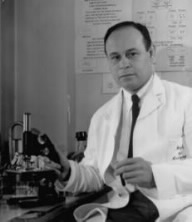
In 1938, while earning a doctorate at Columbia University, Drew won a fellowship to train at Presbyterian Hospital in New York with eminent surgeon Allen Whipple. Instead of following the traditional path of residents to gain experience in surgical pathology and bacteriology, surgical laboratory research, outpatient clinic, operating rooms and surgical wards, Whipple assigned Drew to work under John Scudder, who was granted funding to set up an experimental blood bank. This would prevent him from privileges afforded to his white peers, especially direct access to patients.
Scudder considered his protÉgÉ “naturally great” and a “brilliant pupil” and Whipple would later be won over by Drew’s talent, supporting both his surgical training and doctoral research. Drew and Scudder focused their research on diagnosing and controlling shock, fluid balance, blood chemistry, preservation, and transfusion — the work on which he based his seminal dissertation, "Banked Blood: A Study in Blood Preservation." The thesis also made him the first African American to earn a medical doctorate from Columbia. Scudder remarked that the thesis was “a masterpiece” and “one of the most distinguished essays ever written, both in form and content.”
Drew’s doctoral research assessed previous blood and transfusion research, blood chemistry and fluid replacement, and evaluated variables affecting shelf-life of stored blood — from types and amounts of anticoagulants (substances that prevent blood from clotting) and preservatives, to shapes of storage containers and temperature.
His key findings, complex procedures, and standards for collecting, processing and storing blood proved his expertise and led to an appointment to head the Blood for Britain Project (BFB), an effort to transport desperately needed blood and plasma to Great Britain, which was under attack by Germany.
What is plasma?
Plasma is a clear, yellow liquid containing various proteins and electrolytes that carries blood cells and other substances through the body. It can be used as a blood substitute to help replace fluids and treat shock. There is an advantage to using plasma over whole blood in emergency situations because it:
- keeps longer without refrigeration
- won't deteriorate when agitated during transport
- can be used with any blood type
- is much less likely to transmit diseases
- can be injected through veins, muscles, the skin, and in large doses
Drew worked with Scudder and E. H. L. Corwin to plan the organizational process of safely collecting, processing and storing large amounts of contamination-free plasma along with procedures for extracting plasma and ensuring safe arrival in Britain.
To separate plasma from blood cells, the team used centrifuging (separation of blood components by density) and sedimentation (separation of particles from a liquid). The plasma was then pooled from a collection of eight bottles using an anti-contamination technique under strict air and ultraviolet lighting conditions, and samples were cultured for bacteria. An anti-bacterial called Merthiolate was added to the blood product and batches were tested weekly. Finally, each batch was transferred to a shipping container and diluted with sterile saline solution. A final sample for bacteria-testing was taken before the containers were sealed and packed. By early August, a trial shipment of plasma was sent to England and confirmed "entirely satisfactory."
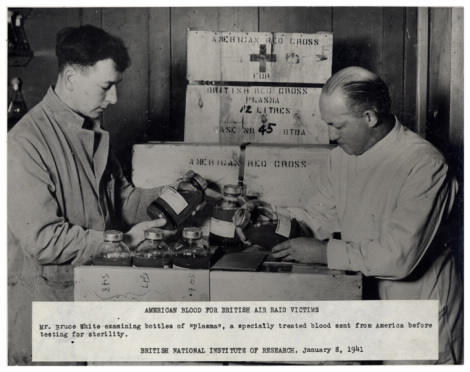
In the midst of the Blood for Britain project, Drew passed the American Board of Surgery exams. “In surgical circles, Drew's performance on the oral part of the exam, in which he confidently lectured his examiners about fluid balance and management of shock, became as legendary as his athletic feats had been at Amherst.”
Drew later returned to Howard briefly but was called back to continue supervising the BFB program. When the program ended in January 1941, Blood for Britain collected 14,556 blood donations, and shipped (via the Red Cross) over 5,000 liters of plasma saline solution to England.
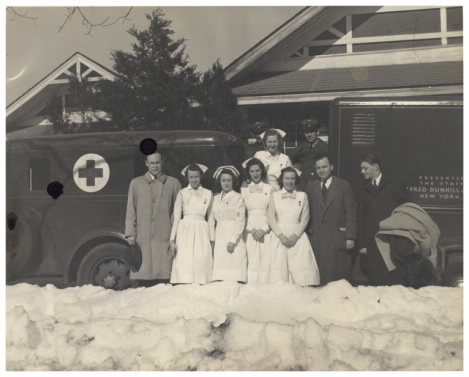
The program became a model for the Red Cross pilot program to mass-produce dried plasma in New York in February 1941, with Drew as assistant director, and later for the National Blood Donor Service. Among his innovations were “bloodmobiles” — mobile blood donation trucks with refrigerators. The work sealed his reputation as a pioneer and earned him the title, “father of the blood bank.”
Ironically, the Red Cross excluded African Americans from donating blood, making Drew himself ineligible to participate in the very program he established. That policy was later modified to accept donations from blacks, however the institution upheld racial segregation of blood, which throughout the war Drew openly criticized as “unscientific and insulting to African Americans.”
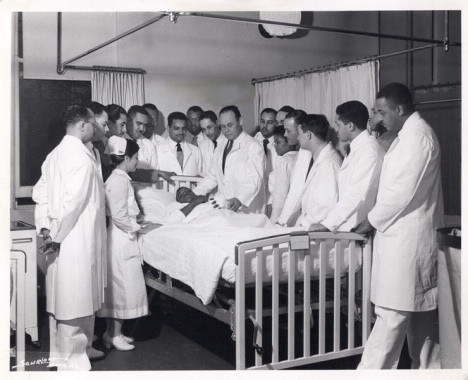
In October 1941, Drew returned to Howard University, where he remained for the next nine years serving as Head of the Department of Surgery and Chief of Surgery at Freedmen's Hospital. His mission was to “train young African American surgeons who would meet the most rigorous standards in any surgical specialty” and “place them in strategic positions throughout the country where they could, in turn, nurture the tradition of excellence.” This he believed would be his “greatest and most lasting contribution to medicine.” He also campaigned against the exclusion of black physicians from local medical societies, medical specialty organizations, and the American Medical Association.
Charles Drew died tragically in North Carolina on April 1, 1950, after falling asleep while driving to a conference. He was given a blood transfusion at an all-white hospital but succumbed to the injuries.
Honors, Awards, Appointments
- Appointed Assistant Director of the First American Red Cross Blood Bank (1941)
- Appointed Head of Department of Surgery at Howard University in Washington, D.C., and chief surgeon at Freedmen’s Hospital (1941)
- Awarded E. S. Jones Award for Research in Medical Science from the John A. Andrew Clinic in Tuskegee, AL (1942)
- Appointed Chief of Staff at Freedmen’s Hospital (1944)
- Awarded Spingarn Medal from the National Association for the Advancement of Colored People for his work on blood plasma (1944)
- Awarded honorary doctorates from Virginia State College (1945) and Amherst College, his undergraduate alma mater (1947)
- Elected fellow of the International College of Surgeons (1946)
- First Black to be appointed examiner for the American Board of Surgery (1948)
- Appointed Surgical Consultant for the United States Army's European Theater of Operations (1949)
Educational Background
- AB, Amherst College, Amherst, MA
- MD and Master of Surgery, McGill University School of Medicine, Montreal, Canada
- Doctorate in Medical Science, Columbia University, New York, NY
Books and Articles on Drew
- Bertol, Roland. CHARLES DREW. New York: Thomas Y. Crowell, 1970. 32 pages.
- Becker, Chrisanne. AFRICAN AMERICANS WHO SHAPED AMERICAN HISTORY: CHARLES R. DREW. San Francisco: Blue Wood Books, 1995.
- Bims, Hamilton. CHARLES DREW’S ‘OTHER’ MEDICAL REVOLUTION. Ebony, February 1974, pp. 88-96.
- Haber, Louis. BLACK PIONEERS OF SCIENCE AND INVENTION. Harcourt, 1970, pp. 151-167.
- Hardwick, Richard. CHARLES RICHARD DREW: PIONEER IN BLOOD RESEARCH. Scribners, 1967.
- Lichello, Robert. PIONEER IN BLOOD PLASMA: DR. CHARLES RICHARD DREW. Simon & Schuster, 1968.
- Love, Spencie. ONE BLOOD: THE DEATH AND RESURRECTION OF CHARLES R. DREW. The University of North Carolina Press, 1996. 373 pages. (For readers in grades 10 and up)
- Mahone-Lonesome, Robyn. CHARLES DREW: PHYSICIAN. Philadelphia: Chelsea House, 1990. 111 pages. (Part of the “Black Americans of Achievement” series for children ages 9 to 12)
- Richardson, Ben. GREAT AMERICAN NEGROES. 1945; rev. ed. 1956.
- Sammons, Vivian Ovelton. BLACKS IN SCIENCE AND MEDICINE. Hemisphere Publishing, 1990, pp. 78-79.
- Schraff, Anne E. DR. CHARLES DREW: BLOOD BANK INNOVATOR. Berkeley Heights, N.J.: Enslow Publishers, Inc. 2003. 112 pages. (Part of the African-American Biographies series for 6th grade readers and up)
- Steme, Emma Gelders. BLOOD BROTHERS: FOUR MEN OF SCIENCE. 1959
- Trice, Linda. CHARLES DREW: PIONEER OF BLOOD PLASMA. New York: McGraw-Hill, 2000. 121 pages.
(Part of the “Ideas on Trial” series for young adult readers) - Whitehurst, Susan. DR. CHARLES DREW: MEDICAL PIONEERR. Chanhassen, MN: Child’s World, Inc., 2002. 40 pages.
(Part of the “Journey to Freedom®: The African American Library” series for readers in grades 5 and up) - Wynes, Charles. CHARLES RICHARD DREW: THE MAN AND THE MYTH. University of Illinois Press, 1988.
Educational Resources
- The Charles R. Drew Papers. (n.d.). Retrieved from http://profiles.nlm.nih.gov/BG/
- Drew, C. R. (1950). Negro scholars in scientific research. The Journal of Negro History, 35(2), pp. 135-149. doi:10.2307/2715857
- Charles Drew. (n.d.) Retrieved from https://www.amherst.edu/campaign/amherst_lives/charles_drew
- Dr. Charles Drew (1904-1950): Medical Pioneer. (n.d.) Retrieved from http://redcross.org/museum/history/charlesdrew.asp
- Red Gold. The Epic Story of Blood – Charles Drew. (2002) Retrieved from http://www.pbs.org/wnet/redgold/innovators/bio_drew.html.
